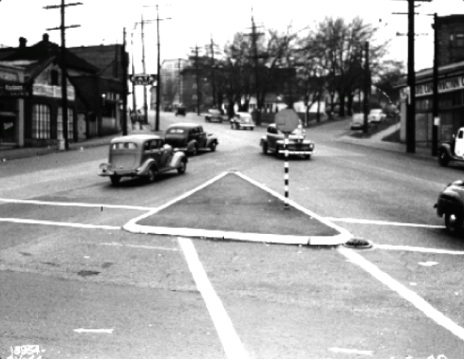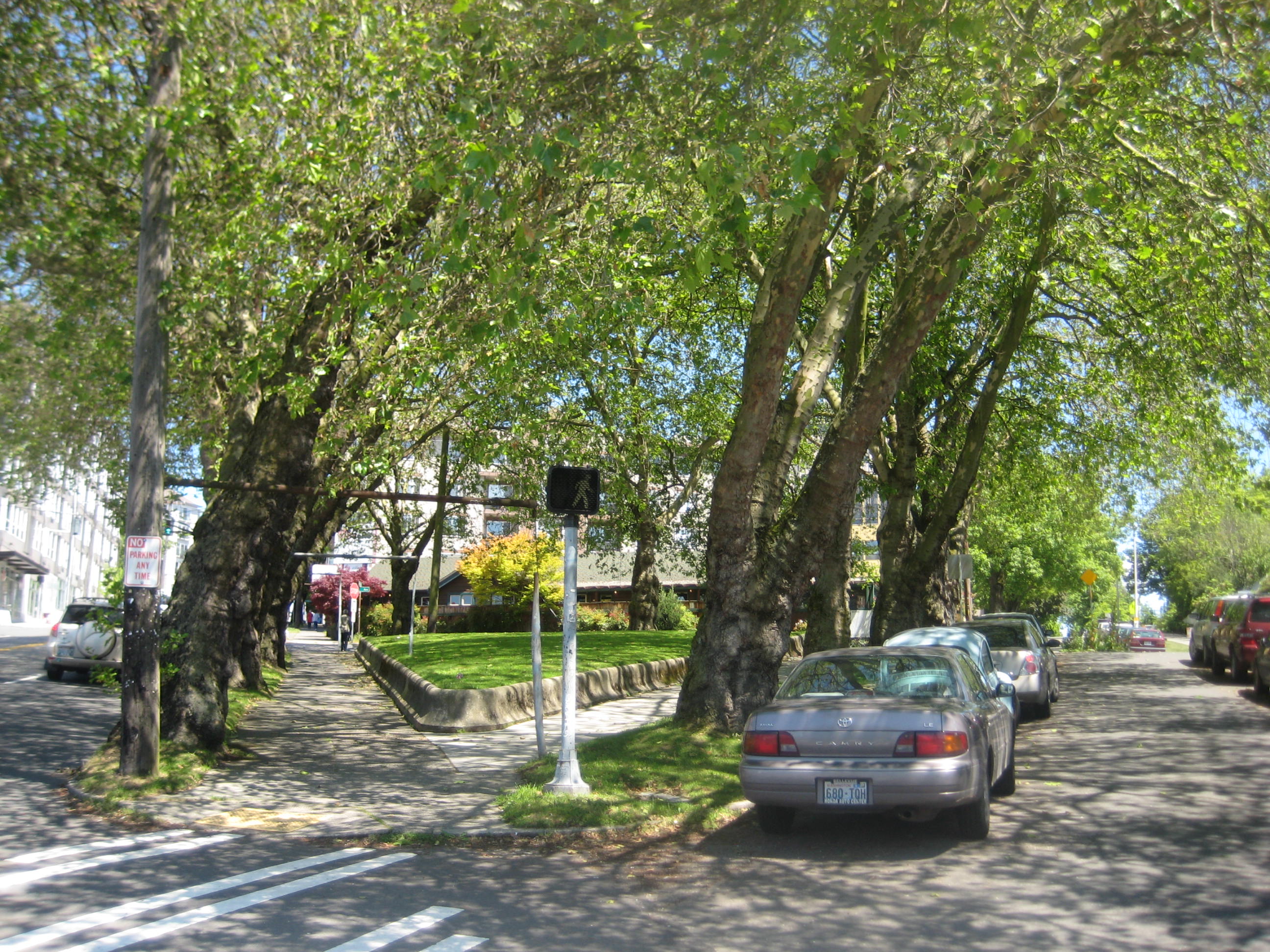Last Tuesday, a group of students from Seattle University’s Community Design Workshop presented their research on McGilvra Place Park in a talk entitled, McGilvra Place: A Reconnaissance Study of a Pocket Park. In front of a crowd of about 40 people made up of both fellow students and community members, the two project managers, Chase Clancy and Leah Julius summed up the findings of four project teams, which analyzed various aspects of the small, triangular park off Madison and 15th Avenue. The presenters set the tone of the presentation by starting a real-time video of the park, filmed from the top of a nearby apartment complex, and challenging the audience to find a single person actually using the park during the duration of the talk.
 McGilvra Place, 1944 (background). Courtesy of Chase Clancy
McGilvra Place, 1944 (background). Courtesy of Chase Clancy
The presentation started off with the basics: It is a 2,600 square foot park with eleven 60-70 year old London Plane Trees, and a small patch of grass surrounded by a nearly two foot high cement wall. The park came about when the city street grid was extended across Madison street, leaving a small,disconnected parcel between Madison, 15th, and E. Pike street. The land was officially acquired by the city in 1901 and named after U.S. Attorney of Washington Territory, John J. McGilvra, the man who funded the original “Madison Street Improvements” in order to connect his Lake Washington estate with downtown Seattle. Although included in both the Central District and Capitol Hill Neighborhood Plans, there have been no significant improvements to the park other than the initial planting of the London Planes. Today the Parks Department spends about 60 hours and $3,622 a year maintaining the park.
Next, the presenters went on to the “meat of the project” as Julius put it, displaying their findings about human behavior in and around the park. The project team set up observations at four different time-blocks throughout the day and logged a grand total of 36 hours of park watching. Although the observers witnessed 1,400 people in the park area, they saw a mere 12 actually use the park itself. Of those 12, eight simply walked through the park, leaving just 4 out of 1,400 people who sat or laid in the green space. When interviewed, 80% of people said they weren’t even aware that the open space was indeed a park, and the majority said the area felt “unwelcoming and cold.” One common perception of the park was that it was used by the homeless population as a place to sleep, yet, observers did not directly witness any of this activity. The team spoke with East Precinct Sergeant Jay Shin about this issue and he did say that they were asked to increase patrols of the park two months ago, but he also emphasized that all members of the public are allowed to utilize the park during regular park hours.
The human observations in the park highlighted the main theme of the presentation: Even though the park sits in the midst of a dense urban neighborhood, it is vastly underutilized. They recommended a number of park improvements that could highlight the park’s unique position at the intersection of some of Seattle’s most culturally rich neighborhoods. For example, they suggested some possible “decorative boulders” that could be used both as interpretive signage as well as seating. They also recommended a number of green features, such as bio-swales, but they pointed out that the current slope of the park is too steep for such additions, and would need some regrading to make it work. Acknowledging the city’s troubling financial situation, they recommended a public-private partnership as a possible funding source, pointing to the success of the Portland Parks Foundation as a model.
Two of the most likely candidates for a public-private partnership could be Point32 Development, which is set to build the Cascadia Center for Sustainable Design and Construction just east of the park on 15th Avenue, and the Bullitt Foundation, which plans on occupying a portion of the Cascadia Center after completion. Point32 CEO Chris Rogers and Bullitt Foundation Director Dennis Hayes both watched intently during the presentation and stuck around afterward to chat with the presenters and answer questions. When asked what kind of financial commitments Bullitt was willing to provide to the park, Hayes said that they are currently open to all options. Rogers said that they are considering having a shared buy-in from all tenants of the Cascadia Center that would contribute to the maintenance and improvement of the park.
One of the most interesting parts of the presentation was when CHS itself was invoked during the question and answer session. Point32 CEO Rogers asked whether the team looked into vacating 15th between Madison and Pike, suggesting it could provide additional space for the park. Clancy said it was a possibility, but that comments on CHS’s preview of the McGilvra study illustrated that some people were worried about the park being incorporated into the Cascadia Center’s campus. He recommended that further public outreach be done on that particular issue. Both Hayes and Rogers seemed stunned by the possibility raised in comments on CHS and when asked later Hayes said he believed that closing 15th to vehicle traffic could make the park and the Cascadia Center more accessible to the public, not less. CHS will let you know if there are additional public meetings on the topic, but until then, feel free to share your opinions below and perhaps we can again help shape the discussion on this little park.




I’m unclear when this group surveyed the park for usage. I live across the street and do see it used on sunny summer days with picnics and folks just sitting and reading. Trust me, it is used, yes as sleeping quarters (on the edge) by the homeless but also by residents in the area. Boulders? Bad idea. . .just keep the beautiful green grass.
Given this is a class project, it seems pretty obivious that the survey wouldn’t have been done in the summer. Why would they have done the survey last summer and waited an entire school year to present their findings.
I’m not sure why boulders are a bad idea. I’m not saying they are a good idea but maybe you could elaborate on your complaining.
Grass lawns don’t work unless there is good sun. Look at Cal Anderson Park to see an example where grass works. I think McGilvra would be much more utilized as a plaza extending out from the new Cascadia Center. Imagine a nice space with benches and a fountain or statue in the middle, something that reflects the history of the area. It would provide a calm place to sit and read or reflect under those great trees. There are lots of small parks like that in Manhattan that I think we could emulate.
I also think 15th should be closed to traffic. Anytime you have a diagonal like Madison it creates lots of useless bits of road that just make intersections more complicated and difficult for both cars and pedestrians. As long as McGilvra is clearly open to the public and does not appear to be part of the development, it would be an improvement.
This “park” isn’t used by anyone but homeless and CC’s regulars who need a place to pee. And we want to dump *more* money into it?
This town get very ridiculous when we see a poorly located site open up and immediately scream “Turn it into green space! More parks! Boo developers!” Here’s a park that has had, what, 110 years to develop an user base? And obviously, its amazing vantage point — with a breathtaking view of the former Taco Time property — is something this city must work hard to preserve.
Enough. We have to cut police protection and other key city services to keep parks like this “alive,” and they still die. Let’s put it to pasture. Bring in a developer to stick some affordable housing here, please.
The park costs $3622 a year to maintain. A sworn police officer with 54+ months of experience gets 84k a year. Repurposing these funds would get you a really tiny cop.
And make a triangle building. Maybe the city can recoup some of that 1.2M they’re blowing on the Republican & Federal debacle.
We can “recycle” the trees and make them into furniture.
simple.
the trees already provide perceived ‘protection’ from cars. add a fence to keep little ones in.
and closing 15th is agreat idea FWIW – less traffic around parks = WIN.
I walk by this park every day on my way to and from work. On hot summer days, as I’m trudging up Madison, with the sun baking my back as I pass by Piecora’s, I can’t wait to get under those huge beatiful trees and all of their cool leafy goodness. I love to look up at the canopy as I walk underneath and marvel at how the branches manage to extend across and interconnect, covering the whole triangle perfectly. Yes, I use this park every day, but I’m sure I wasn’t counted as a user. It’s a wonderful green oasis, and I wouldn’t change a thing about it.